#north american birds
Text
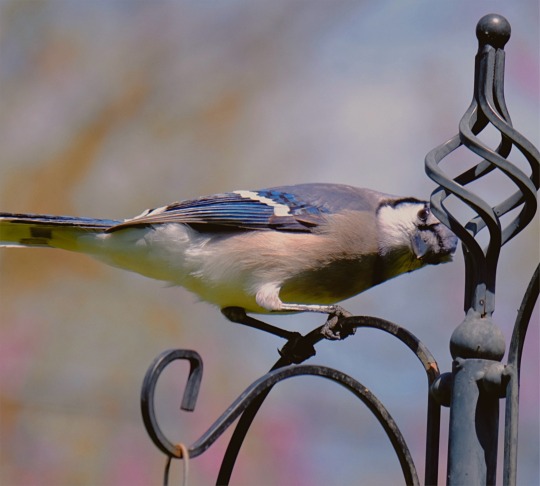

Curious Blue Jay looking at me this morning!
Photo taken by me on FujiFilm X-T30 II
#animals#animal#photography#photographer#animal photography#nature#nature photography#bird#bird photography#wildlife#wildlife photography#wildlife photographer#birds#birdwatching#birding#fujifilm#blue Jay#Jay#corvid#corvids#blue#north american birds#wild birds
137 notes
·
View notes
Text
BOTD: Bronzed Cowbird
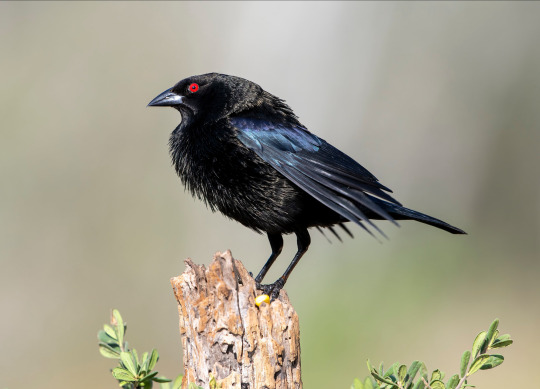
Photo: Doug Greenberg
"Larger than the Brown-headed Cowbird and mostly restricted to the Southwest, this species is another brood parasite. It may be more specialized in its choice of 'hosts,' and is thought to have seriously affected populations of some species, such as Hooded Orioles in southern Texas. The Bronzed Cowbird has expanded its range in our area during the last century; in Arizona, where it is now common, it was unrecorded before 1909."
- Audubon Field Guide
#birds#bronzed cowbird#birds of north america#north american birds#cowbirds#blackbirds#passerines#birds of the us#birds of mexico#birds of central america#birding#birdblr#birblr#bird watching#bird of the day#Molothrus aeneus
78 notes
·
View notes
Photo
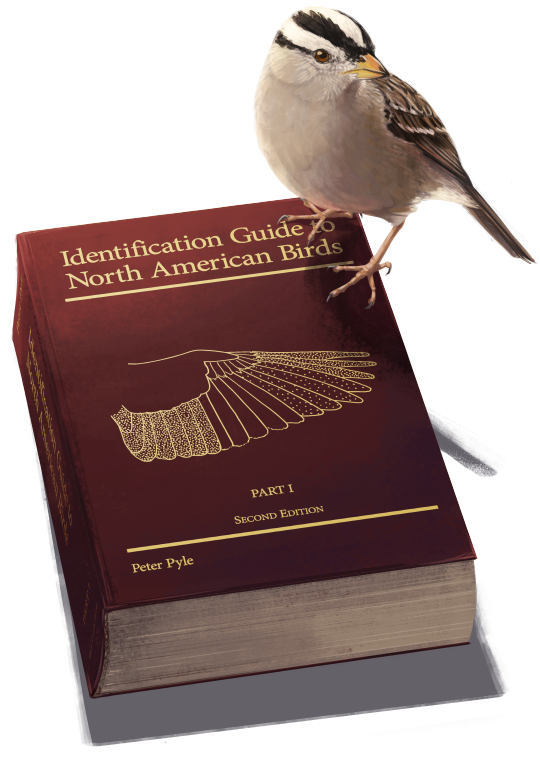
The second edition of Peter Pyle’s ID Guide to North American Birds is now out! We’ve all been waiting a long time - and boy is it worth the wait, with new species and updated info. We’ve learned a lot since the original release in 1997!
I did a version of this illustration in 2020 but here’s the version used in the promo releases now that the actual cover is finalized! Bird banders, and collectors of esoteric bird knowledge, can now find this at Buteo Books and at Slate Creek Press.
#scientific illustration#birdblr#ornithology#white-crowned sparrow#sparrow#birds#peter pyle#north american birds#artists on tumblr
518 notes
·
View notes
Text


I can’t share any WIPs I’m working on atm but I can share this half-hour sketch I did of a northern saw-whet owl!
I found out about the existence of this little guy through a uquiz (link below) and immediately fell in love with it. IT IS SO SMALL AND ITS EYES LOOK LIKE DOLL EYES AND I AM OBSESSED WITH IT. I LOVE IT!!! IT LOOKS LIKE THE FLOOSHED EMOTE.
uquiz: Which Animal Is Your Familiar? (North America Edition)
#northern saw-whet owl#birds#owl#north american birds#illustration#artists on tumblr#animal illustration#art#sketch#bird art#my art
88 notes
·
View notes
Text
Going to do a series of northeast us bird appreciation posts so....
Chimney Swifts!



You'd usually find unique birds in a forest, but towns and cities are these guys' forests! They dart around the tops of buildings so high in the sky and chittering so energetically!! They fly like little boomerangs! You hear their noise and look up and they are there!!

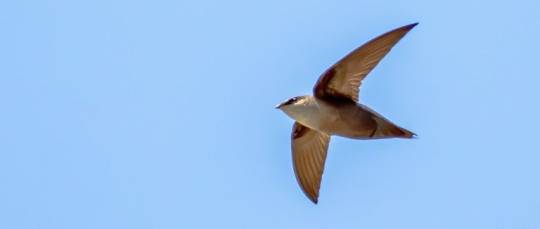
Swooping and gliding and flapping and chirping.... the life of a tiny little arrow in the sky....
#birds#biology#birding#birdwatching#birdwatcher#northeastern us#northeast us#northeastern united states#birds of north america#north american birds#chimney swift
103 notes
·
View notes
Text
Genus: Setophaga
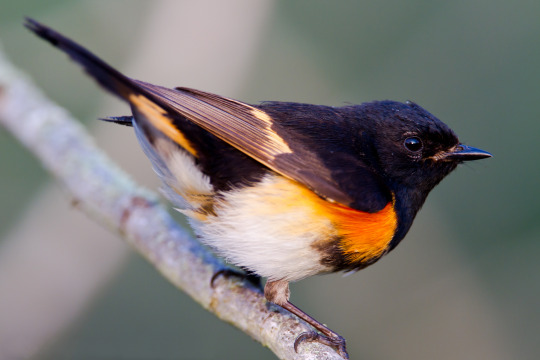
Originally, this genus was only used for the American Redstart (Setophaga ruticilla). Meaning 'moth-eater', it was used to refer to the flycatcher-like habits of the American Restart, which sallies forth from a perch to catch flying insects rather than plucking them from vegetation.
In 2010, however, a newly published paper disrupted what was thought of Parulidae taxonomy. Using a comprehensive molecular phylogenetic analysis of the family, several genus were merged into Setophaga. Not only that, but a separate genus of warbler was cleaved in two based on the findings.
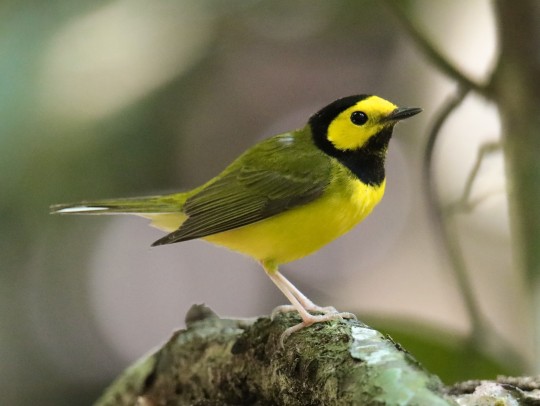
The Hooded Warbler was previously listed under the genus Wilsonia along with Wilson's Warbler and Canada Warbler. They had even been in an obsolete genus together before this (Sylvania), though this was changed to Wilsonia for other reasons. The 2010 study showed that Wilsonia was polyphyletic, meaning the group may share similar traits, but do not share a common ancestor. Hooded Warbler was moved to Setophaga and Wilson's and Canada Warbler were placed into Cardellina, an existing genus with Red-faced, Pink-headed, and Red Warbler.

The two Parula species were also folded into Setophaga as a result of the 2010 study. The Northern and Tropical Parula were originally the only two members of this genus, with the Northern Parula being the type-specimen of New World Warblers as a whole. I find that a bit ironic, as they are one of the smallest warblers and show quite an unusual color patter when compared to the rest of Parulidae, but I don't exactly know how type-specimen are chosen.

The largest genus to be merged with Setophaga was Dendroica. When I first began learning species names, I was familiar with this as the genus for most warblers. Due to the way taxonomic names work, the name which was published first takes precedent in these merging scenarios. So, despite the fact Dendroica had around 30 species and Setophaga had just 1, Setophaga was published first in 1827 (Dendroica in 1842).
In summary, Setophaga went from just a single species to now being the largest in the Parulid family, holding 34 species!
Image Sources: AMRE (Dan Pancamo); HOWA (Ninahale); NOPA (Dan Pancamo); MAWA (Cephas)
#setophaga#parulidae#passeriformes#bird#north american birds#american birds#american redstart#hooded warbler#northern parula#magnolia warbler#(had to include MAWA in there they're babyyyy)#(also hi I'm wikipedia now I guess. linking to other wiki pages within my own article like damn lol)#Genus Feature
39 notes
·
View notes
Text


Baltimore oriole - female (top) and male (bottom)
Photos by Bob Dunlap
#baltimore oriole#oriole#orioles#icterus galbula#icterus#birds#yellow birds#passerine birds#north american birds#yellow#animals#wildlife#nature
10 notes
·
View notes
Text
I saw an American kestrel today! (I’m not showing pics because they’re blurry iPhone 7 pics) it was so cute resting on a bush
#american kestrel#birding#birdlr#nature is everything#falcons#north american birds#bird lover#wildlife
6 notes
·
View notes
Text
Little help needed for identifying a bird.
is there any birds who are native to North America that could fit this description?
“a species of red partridge, which is very common (tetra lagopus, Lin.) differs from that in Europe in being much larger. The circumference of the eyes is ornamented with a fleshy ring of a scarlet colour. The beak is red, and the toes are covered with thick grey silk or hair, down to the nails. These partridges are also red with brown spots in the summer, and white in winter, as I know from observation. It is also said that this change of colour takes place without a change of plumage.”
I’m currently the first volume of the “Memoirs of Military Surgery” by Dominique Jean Larrey, who spent some time in Newfoundland. I can figure out all the animals he’s describing except this one.
anyone have any ideas?
#It’s gonna drive me crazy#I’ve asked everybody I know#No one can seem to figure it out#Larrey#memoirs#dominique jean larrey#Newfoundland#birds#North American birds#Help#Ask
5 notes
·
View notes
Text
BOTD: Yellow-eared Toucanet

Photo: Cathie Barron
"Small toucan with distinctive plumage pattern. Male has black body with bright yellow cheek patch; also note olive back and orange patch on flanks. Female similar; she lacks the yellow cheek patch but still has bright yellow-teal skin around the eye. Found in the forest canopy, usually in pairs or small family groups. Feeds on fruits, and sometimes perches conspicuously on an open branch."
- eBird
#birds#yellow eared toucanet#birds of north america#north american birds#toucans#toucanets#birds of central america#birding#bird watching#birdblr#birblr#bird of the day#Selenidera spectabilis
30 notes
·
View notes
Text
Baltimore Oriole
icterus galbula
Makes Woven Fiber hanging Nests
Loves eating ripe fruit, jelly and nectar
Males make a flutelike whistling(this guy is a male!)
#digital art#art#artists on tumblr#artwork#painting#procreate#digital artist#queer artist#ornithology#orioles#baltimore orioles#bird art#birds#north american birds
5 notes
·
View notes
Photo

Birds :^)
9 notes
·
View notes
Text
Yellow-rumped Warbler (Setophaga coronata)
There are (currently) four subspecies within Setophaga coronata:
Myrtle Warbler (S.c. coronata)
Audubon's Warbler (S.c. auduboni)
Black-fronted Warbler (S.c. nigrifrons)
Goldman's Warbler (S.c. goldmani)
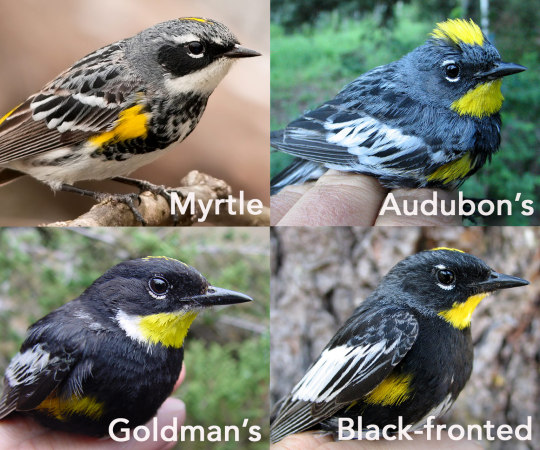
Our story (my rambling) begins with Myrtle and Audubon's Warblers being described as separate species, until a study in 1973 found evidence that the two routinely hybridized within a small strip of Western Canada. The Biological Species Concept* defines a species as any members of a population which can interbreed and create fertile offspring, and with the limited genetic evidence of the time, this concept was used to lump Myrtle and Audubon's into the Yellow-rumped Warbler. (*keep in mind there are many ways to define a species, so this single concept isnt a "be all, end all" argument)
This hybrid zone, however, is only 80 miles across, and has been shown to be stable over the past 50 years, suggesting the hybrids may not be as viable as previously thought. This, coupled with a new and overwhelming comparison between the birds' genomes, suggests that Myrtle and Audubon's Warblers are indeed separate species.
So the story goes back even further, because this story is really about bird populations and not our human ability to categorize them. The most likely situation is that the Myrtle Warbler was separated from the other three forms of the species during the Pleistocene glaciation, over the last million years or so. This pattern can also be seen in other "paired" species from East to West, such as Baltimore and Bullock's Orioles, or Rose-breasted and Black-headed Grosbeaks. The glaciers cut off the breeding population of Myrtle Warblers, and only after their receding could they move West to meet in the middle again.
In an interesting twist, the leading idea is that Audubon's Warbler is not only a separate species, but is actually a hybrid species which arose from Myrtle meeting the Black-fronted Warbler once it expanded back West. This hypothesis is supported by mitochondrial DNA of a sedentary population of Audubon's being very similar to Black-fronted, rather than to Myrtle Warblers. There needs to be more study into the genomics of these birds to confirm whether or not Audubon's would stand as it's own species, or if it and Black-fronted are more closely related.
Off to the side of all this is Goldman's Warbler, which makes sense when you take a look at the breeding range of these warblers. Black-fronted and Goldman's Warbler are both non-migratory birds, and the population of Goldman's Warbler is located almost entirely in Guatemala, with possible populations to the west in Chiapas, Mexico. In the same genomics study above, Goldman's Warbler stood out as unique when compared to both Myrtle and Audubon's DNA.
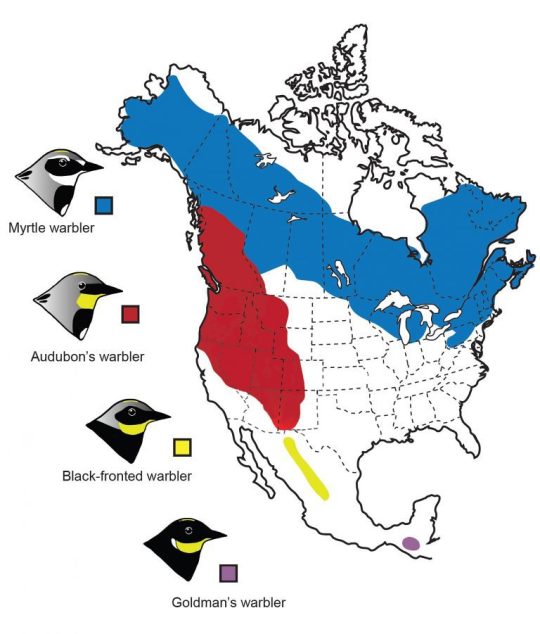
To sum this up: more study is needed between Myrtle, Audubon's, and Black-fronted to confirm previous findings, but a three-way species split from this single species seems to be supported. The International Ornithological Congress (IOS) has already done so, splitting Yellow-rumped Warbler into Myrtle, Audubon's (with Black-fronted as a subspecies), and Goldman's Warbler.
While we're on the topic- hybridization between Setophaga warblers is not unheard of, and Yellow-rumped Warbler has multiple documented hybrids in the Macaulay library. I won't post all the pictures, but the best are linked as follows: Cape May, Magnolia, Palm, Yellow-throated, Grace's, Townsend's, Hermit, Black-throated Green). Other than it's own species-complex, Yellow-rumps are most closely related to Yellow-throated and Bahama Warbler.
Sources Below
Wikipedia (for ease of summarization)
Birds of the World (for the more in-depth story)
Barry the Birder (for the compiled image of all four birds, and for talking about the All About Birds article so I could find and link that)
All About Birds (for the range-pic, and for summarizing the study from The Auk- way better than I did, I may add. Go read their article if this intrigued you.)
Papers cited in Birds of the World:
[on 'lumping' YRWA] Eisenmann, E. (1973). Thirty-second supplement to the American Ornithologists' Union check-list of North American birds. Auk 90: 411–419.
[on the hybrid zone] Hubbard, J. P. (1969). The relationships and evolution of the Dendroica coronata complex. Auk 86:393-432.
[hybrid zone] Barrowclough, G. F. (1980). Genetic and phenotypic differentiation in a wood warbler (genus Dendroica) hybrid zone. Auk 97:655-668.
[hybrid zone] Brelsford, A., and D. E. Irwin (2009). Incipient speciation despite little assortative mating: the Yellow-rumped Warbler hybrid zone. Evolution 63:3050-3060
[on mtDNA between auduboni and nigrifrons] Milá, B., Toews, D.P.L., Smith, T.B. and Wayne, R.K. (2011). A cryptic contact zone between divergent mitochondrial DNA lineages in southwestern North America supports past introgressive hybridization in the yellow-rumped warbler complex (Aves: Dendroica coronata). Biological Journal of the Linnean Society. 103: 696–706.
[on the 'hybrid origin' of auduboni] Brelsford, A., Milá, B. and Irwin, D.E. (2011). Hybrid origin of Audubon’s Warbler. Molecular Ecology. 20(11): 2380–2389.
[on 'splitting' YRWA] Toews, D.P.L., Brelsford, A., Grossen, C., Milá, B. and Irwin, D.E. (2016). Genomic variation across the Yellow-rumped Warbler species complex. Auk. 133(4): 698–717.
#setophaga#parulidae#passeriformes#birds#north american birds#american birds#yellow rumped warbler#audubon's warbler#myrtle warbler#goldmans warbler#for the purpose of the bird poll I am treating them as separate species#it helped round out the numbers and made showcasing them a bit easier lol
18 notes
·
View notes
Text
has anyone ever told you guys about American Black Vultures because they should have

literal fantasy creatures

their eyes are so kind. this bird would serve me a cup of soup on a cold day. it would be made with decomposed deer but I would appreciate the gesture anyway.

but also man of mystery, predator, imposing dark beast of the sky.
They get a bad rep for occasionally targeting livestock, especially when large groups compete for food, but like most vultures they're mostly carrion feeders.
2 notes
·
View notes